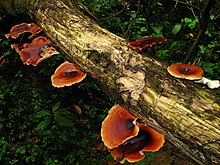| Picipes badius | |
|---|---|

| |
| Specimens showing light coloring (above) and darker pigmentation (below) a few days later | |

| |
| Scientific classification | |
| Domain: | Eukaryota |
| Kingdom: | Fungi |
| Division: | Basidiomycota |
| Class: | Agaricomycetes |
| Order: | Polyporales |
| Family: | Polyporaceae |
| Genus: | Picipes |
| Species: | P. badius
|
| Binomial name | |
| Picipes badius (Pers.) Zmitr. & Kovalenko (2016)
| |
| Synonyms[1] | |
|
List
| |
Picipes badius (formerly Royoporus badius), commonly known as the black-footed polypore or black-leg, is a species of fungus in the family Polyporaceae. It causes a white rot of hardwoods and conifers. The species is found in temperate areas of Asia, Australia, Europe, and North America. It has a dark brown or reddish-brown cap that reaches a diameter of 25 cm (9.8 in), and a stipe that is often completely black or brown at the top and black at the base.